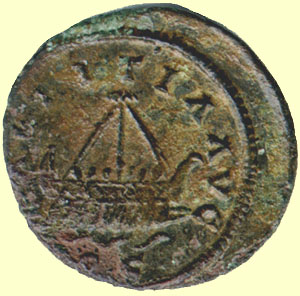 Contents -
Previous Article -
Next Article
Contents -
Previous Article -
Next Article
Corvus
This movable gangplank could be swung out over the side of a Roman ship during battle and dropped on the deck of the enemy ship. Then, Roman soldiers could rush aboard the enemy ships, taking the enemy sailors by complete surprise and cutting them down with their deadly short swords. Roman engineers were always making improvements in the things they borrowed (or took by force) from their neighbors. This improvement on the design of the Carthaginian trireme helped the Romans to sweep the Carthaginian navy from the seas and win the First Punic War, fought with Carthage from 264 to 241 B.C.
Beak
The heavy, bronze reinforced ram or beak was the only weapon of ancient tomes that could sink a ship. Cannon hadn't been invented yet, and land based siege catapaults, which could hurl heavy stones over the wall of a fort, were too heavy and clumsy to be used aboard ships of that day. The men at the oars were made to row as hard as they could, then the ship was turned toward the enemy's broadside. The stout armored ram would tear a hole in the enemy ship's hull, letting the sea in to drown the hapless men caught belowdecks. With the ship mortally wounded, the Roman soldiers leapt upon the remainder of the enemy who still had any fight left in them and quickly put an end to the engagement. Sometimes, if the enemy were stouthearted and experienced warriors who managed to get the upper hand, they might turn things around and capture their attackers’ship!
Towers
Sometimes towers were built on Roman vessels used in war. There are several monuments that have reliefs carved into their sides showing this feature. Most historians believe they were used as a place where archers could shoot their arrows at enemy seamen in the clear above the heads of their shipmates. They may also have been used as a platform from which heavy stones or burning pitch were hurled on an enemy's decks.
Gunwales
The sides, or gunwales of the Roman warship were usually lined with the soldiers' shields. These were often highly decorated with Gorgon's heads or other designs. They also usually carried the unit colors or insignia. You could often tell from a distance which cohort a legionary belonged to by looking at the design on his shield
Oars
The oars were rowed by Roman soldiers (not usually by slaves, as is commonly believed) and were the primary means of propelling the ship through the water during a battle. It took strong, willing men at the benches to drive the trireme fast enough to cut a hole in an enemy hull with her ram.
Rudder
Unlike modern ships, the Roman trireme was steered with a large oar that hung out over the side near the stern (rear) of the ship. Even though it seems quite crude by our standards, the steering oar was really quite efficient for these ships which seldom exceeded 150 feet in length and were used primarily on the Mediterranean Sea during daylight hours.
Sail
Roman warships had two different and independent propulsion systems, or energy sources used to move the ship. Oars were used in calm weather and when going into battle. The sails were used when the wind was blowing in the right direction and not too strong. During the later Roman period, Roman sailors did learn to sail across the wind instead of simply sailing downwind. They never learned to be great naval engineers and innovators like the Greeks and Phoenicians. Their attitude was "Just give me a ship good enough to do the job." They never really adopted naval tactics, either, preferring to wage a sea battle by ramming and boarding the enemy, then using land tactics. When the time for battle drew near, the mast was stepped (taken down) and both mast and sails were stowed (put away).
Roman Seamen
Contrary to what has been depicted in such great Hollywood movies as Cleopatra and Ben Hur, most men at the rowing benches of Roman warships were ordinary legionaries who preferred fighting on land. Though they often grumbled when their commanders required them to row a warship and spend long, seasick months training for an impending sea fight, these true Roman soldiers pitched in and did their part. After all, their lives depended on their ability to row and almost everyone preferred death standing on his two feet in a land battle to a cold, watery grave!
Go to next article:
Go back to previous article:
Return to Table of Contents